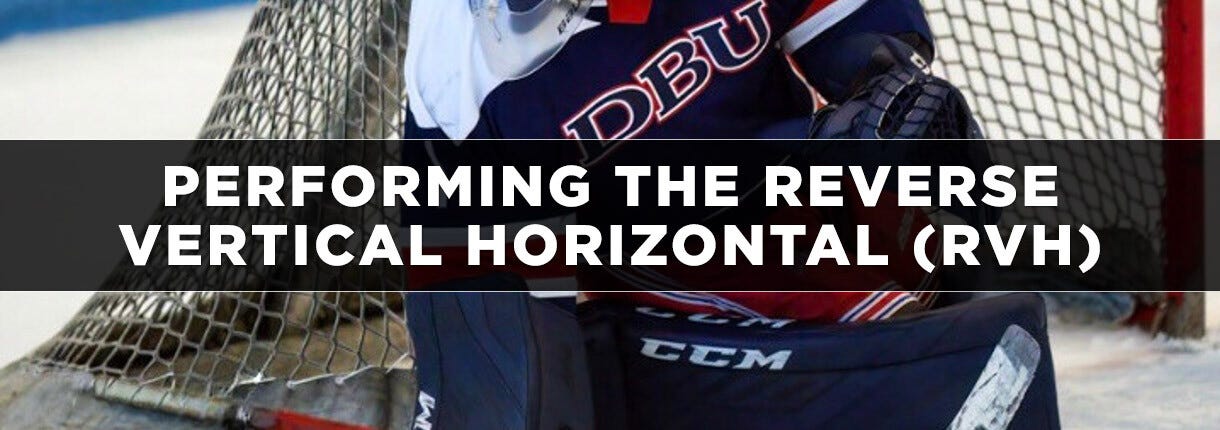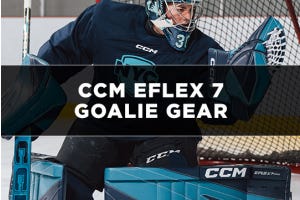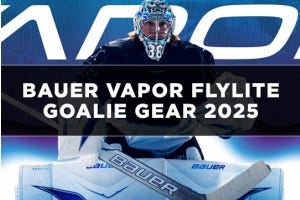Performing the Reverse Vertical Horizontal (RVH)

The Reverse Vertical Horizontal (RVH) is a critical technique for hockey goalies, especially for plays near the post or in tight situations close to the goal line. While it's important for goalies to stay on their feet to remain mobile and ready for various shots, the RVH offers effective coverage for wraparounds, sharp-angle shots, and post plays. However, using RVH in the wrong situations, such as when the puck is far from the net, can leave the goalie vulnerable to easy goals, highlighting the importance of situational awareness and decision-making in using the technique effectively.
In this article, we’ll cover:
Fundamentals of RVH
Initial Stance and Readiness:
- Starting Position: Begin in your standard goalie stance with knees slightly bent, weight on the balls of your feet, and stick on the ice.
- Reading the Play: Determine if RVH is suitable based on the puck's location—typically effective near the post, behind the net, or during wrap-around attempts.
Positioning Mechanics:
- Approaching the Post: Use a lateral push or shuffle to efficiently move towards the post where the puck is located.
- Foot and Pad Alignment:
- Inside Leg (post-side): Drop the knee to the ice, ensuring the pad and skate blade are flush against the post. This seals the lower part of the net.
- Outside Leg: Extend this leg outward toward the middle of the crease, creating a horizontal barrier with your pad to cover more of the ice and to slide if needed.
Upper Body and Stick Placement:
- Post-Side Shoulder: Lean into the post to seal gaps and cover the upper part of the net. Keep your body upright but leaning into the post for maximum coverage.
- Stick Position: Place your stick flat on the ice, parallel to the post, to cover the space between your pads and the post, preventing pucks from slipping through.
Effective RVH Execution
Sealing the Post:
- Pad and Stick: Ensure the lip of the leg pad is tight against the post and the stick is properly placed to cover the five-hole or to block any threats from going in front of the net.
- Upper Body: Position your glove and blocker to be ready for potential high shots and to seal the side of your body on the post effectively.
Advanced Positioning:
- Overlap RVH: Utilize this technique when anticipating high short side shots and no potential back door threats. Position the skate slightly outside the post to have your body fully covering the tight angle.
- Post Integration: RVH helps in creating a strong barrier at the post to prevent short-side goals, particularly effective in scenarios where the puck is behind the net or in tight corners.
Transitioning In and Out of RVH
Moving Out of RVH:
- Puck Movement: If the puck moves away from the post, push off with your outside leg to return to a standard stance or butterfly position.
- Transition Drills: Practice transitioning smoothly from RVH to other positions. Incorporate exercises that simulate game scenarios for effective movement.
Post-to-Post Movement:
- Butterfly Slides: Use butterfly slides for quick lateral movement across the crease while maintaining a low, balanced stance.
- Maintaining Balance: Focus on controlled movements to avoid overcommitting and being caught out of position.
Practicing RVH
Drills and Exercises:
- Stationary RVH Practice: Work on holding the RVH position against the post, focusing on sealing gaps and maintaining balance.
- Post-to-Post Transitions: Set up drills to practice moving quickly between posts, ensuring efficient and smooth transitions.
- Reaction Saves: Use drills with sharp-angle shots and wraparounds to enhance your reaction time and effectiveness in RVH.
Video Analysis:
- Professional Review: Study how professional goalies implement RVH in game situations. Focus on their technique, body positioning, and decision-making.
- Self-Assessment: Record your practice sessions to review your RVH execution, identifying areas for improvement in sealing gaps, transitions, and overall balance.
RVH Strategy and FAQs
When is RVH most effective?
RVH is ideal for near-post plays, such as wraparounds and sharp-angle shots, where the puck is close to the goal line.
How can RVH be useful during scrambles and quick plays?
RVH helps goalies maintain a compact position, allowing for quick reactions to passes or shots in tight situations around the crease.
When should you avoid using RVH?
Avoid RVH when the puck is far from the net, like at the blue line, to maintain better mobility and tracking.
What are common mistakes goalies make with RVH?
Not sealing the post properly, allowing gaps between the pad and post.
What is the overlap RVH, and when should you use it?
Overlap RVH involves positioning your skate slightly outside the post to improve coverage on high short-side shots, especially when anticipating a quick release.











